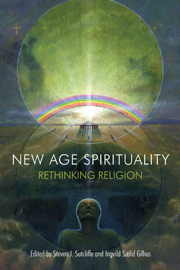Book contents
- Frontmatter
- Contents
- Introduction: “All mixed up” – thinking about religion in relation to New Age spiritualities
- Part I Rethinking New Age spiritualities
- Part II Comparing New Age beliefs and practices
- Part III Putting new spiritual practices to work
- 11 Beyond the spiritual supermarket: the social and public significance of New Age spirituality
- 12 From New Age to new spiritualities: secular sacralizations on the borders of religion
- 13 Cognitively optimal religiosity: New Age as a case study
- 14 Theorizing emotions in New Age practices: an analysis of feeling rules in self-religion
- 15 Doing things with angels: agency, alterity and practices of enchantment
- Conclusion: New Age spiritualities – “good to think” in the study of religion
- Contributors
- Further reading
- Bibliography
- Index
14 - Theorizing emotions in New Age practices: an analysis of feeling rules in self-religion
from Part III - Putting new spiritual practices to work
- Frontmatter
- Contents
- Introduction: “All mixed up” – thinking about religion in relation to New Age spiritualities
- Part I Rethinking New Age spiritualities
- Part II Comparing New Age beliefs and practices
- Part III Putting new spiritual practices to work
- 11 Beyond the spiritual supermarket: the social and public significance of New Age spirituality
- 12 From New Age to new spiritualities: secular sacralizations on the borders of religion
- 13 Cognitively optimal religiosity: New Age as a case study
- 14 Theorizing emotions in New Age practices: an analysis of feeling rules in self-religion
- 15 Doing things with angels: agency, alterity and practices of enchantment
- Conclusion: New Age spiritualities – “good to think” in the study of religion
- Contributors
- Further reading
- Bibliography
- Index
Summary
NEW AGE PRACTICES IN TAIWAN
This chapter provides a sociological analysis of emotions and feeling rules in New Age practices about self-transformation. Based on ethnographic fieldwork, it employs a social constructionist approach to examine the issues of emotions with regard to self-transformation in two New Age healing practices in Taiwan: A Course in Light (ACIL) and Divine Will (DW). I argue that it is important to insert the issue of emotions into New Age discourse because it is the key element to understanding the experiences of self-transformation for participants. In particular, I look at the way participants manage and change their emotions in New Age practices in terms of self-reflexivity and of feeling rules. Participants in New Age practices deal with emotions at both personal and interactive or interpersonal levels. At the personal level, participants experience the transformation of emotions through the reflexivity of the self, which involves a process of emotional identification, experiences and displays. In respect of the interactive level, emotion work is used in practices such as ACIL to deal with emotional conflicts between participants.
Since the 1970s sociologists have done abundant research regarding the position of emotions in social life and on the influence of emotions on human interaction. In a review of the literature Jonathan Turner and Jan Stets have identified seven types of sociological theory of emotions, which are (1) dramaturgical and cultural theories, (2) ritual theories, (3) symbolic interactionist theories, (4) symbolic interactionist theories incorporating psychoanalytic ideas, (5) exchange theories, (6) structural theories, and (7) evolutionary theories (Turner & Stets 2005; Stets & Turner 2007).
- Type
- Chapter
- Information
- New Age SpiritualityRethinking Religion, pp. 227 - 241Publisher: Acumen PublishingPrint publication year: 2013



